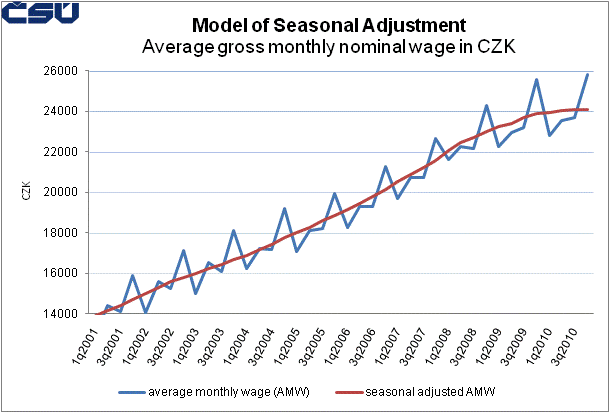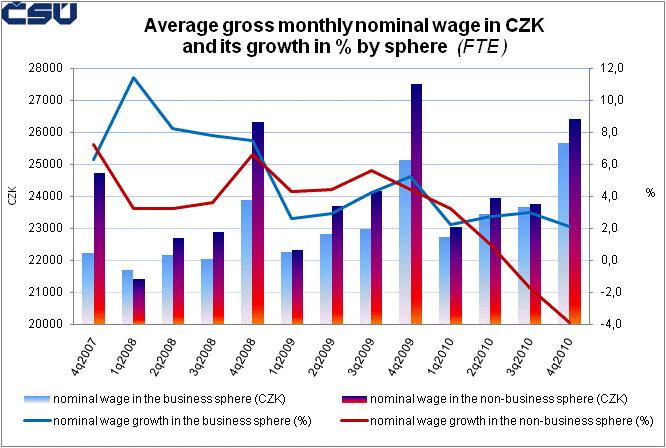Analysis of the development of average wages of employees - 4 quarter
11.03.2011
Code: q-3134-10
The registered number of employees FTE overall fell by 1.2%, i.e. by 46 thousand, in Q4 2010, compared to the corresponding period of the previous year. The year-on-year (y-o-y) change in the average wage is therefore almost not affected by the change in employment and not distorted by structural effects. This laid bare the real trend in wage development and the fact the wage growth was actually halted.
Concerning respective activities the development in the registered number of employees was, however, found rather differentiated, although there is no dramatic change in terms of numbers. An increase in employment was observed mostly in ‘other service activities’ (+5.6%) and in ‘financial and insurance activities’ (+3.9%), and, furthermore, in ‘real estate activities’ (+1.3%) and ‘human health and social work activities’ (+1.1%). An important turn to better times was recorded in ‘manufacturing’, which suffered the most by depression. Because of this industry size the increase by 1.1% means the growth in the number of employees by 11.9 thousand. On the other side, activities in ‘accommodation and food service activities’ (-9.1%), ‘agriculture, forestry and fishing’ (-5.8%), ‘electricity, gas, steam and air conditioning supply’ (-5.7%), ‘construction’ (-5.3%), and ‘transportation and storage’ (-4.1%) experienced deep drop in the number of employees. The laying off in the ‘public administration and defence; compulsory social security’ was demonstrated (-2.0 %, i.e. -5.8 thousand) as well.
The business and non-business spheres did not follow different development paths anymore. Both of them experienced a minute drop in employment. Yet till Q3 2010 the number of employees in the non-business sphere was slightly increasing, which partially compensated the significant drop in the business sphere suffering from depression, which is still fading away now. Recovery in the business sphere is therefore demonstrated rather in the increase of work hours and in the year-on-year growth in the overtime work share.
Concerning the average wage itself (as the arithmetic average calculated as the ratio of wage volume and employees FTE) the increase recorded was the significantly lowest one at all since the beginning of this time series in 2000. The average wage increase was mere 0.9%, nominally, compared to the corresponding period of the previous year. Moreover, the quarter-on-quarter increase in Q4 2010 in the seasonally adjusted model was zero, see Graph No. 1, which has not been noticed so far.
The second adverse factor is the gradually increasing price level (inflation) expressed as the consumer price index, which in Q4 2010 climbed to 102.1, that means the highest level since the first quarter of 2009. Thus the total real wage in Q4 2010 fell by 1.2%, y-o-y.
The business sphere saw the real wage stagnation, y-o-y, that means the wages grew as fast as consumer prices (by 2.1%), while in the non-business sphere the average real wage dropped by 5.9% and was already decreasing for the third consecutive quarter. The non-business sphere, which involves more employees with a higher level of education, has, over the long term, a higher arithmetic average of salaries compared to the business sphere, especially in the fourth quarters, and even the latest trend did not change the fact.
The development is also strongly differentiated concerning economic activities. Wages fell most significantly in real terms in ‘education’ (-7.7%), ‘financial and insurance activities’ (-6.7%), and in ‘public administration and defence; compulsory social security’ (-5.5%). A rather significant positive growth of the real wage was recorded in ‘agriculture, forestry and fishing’ (+5.9%), where this increase is, however, connected to the previous low comparison basis, and furthermore in ‘water supply; sewerage, waste management and remediation activities’ (+5.1%) only. What is satisfactory is the positive, although not high, increase in ‘manufacturing’ (+1.7%) and re-established increase in wages in ‘accommodation and food service activities’ (+2.4%), in which this may be also assigned to consequences of laying-off, see above. In the rest of groups of activities the real wage increase fell within the interval from +2 to -5 per cent.
* * *
Over the whole year (all quarters) of 2010 the average wage in the entire Czech national economy increased by 2.0%, nominally, and by 0.5% in real terms. In the business sphere it rose by 1.1% in real terms and in the non-business one it dropped by 2.1%.
This cumulative data still demonstrates effects of the decrease in the number of employees in a great part of economy, which was relatively highest of all in ‘accommodation and food service activities’
(-8.3%), ‘agriculture, forestry and fishing’ (-7.1%), and in ‘electricity, gas, steam and air conditioning supply’ (-6.8%). ‘Construction’ was also affected by the laying-off (-5.6%). In terms of the number the drop was largest, by 30 thousand persons (-2.8%), in ‘manufacturing’. On the contrary, an important increase was recorded in ‘other service activities’ (+6.7%, i.e. 2.8 thousand).
Concerning the development in the average real wage over the entire year 2010 a rather important increase was recorded in ‘mining and quarrying’ (+3.4%) and ‘water supply; sewerage, waste management and remediation activities’ (+2.7%). The most dramatic drops were noticed, on the contrary, in ‘education’ and ‘financial and insurance activities’ (identically by -3.0%). Nevertheless, ‘financial and insurance activities’ still maintained the highest level of the average wage (CZK 46 436), followed by ‘information and communication’ (CZK 43 527). ‘Accommodation and food service activities’ occupied the place on the opposite end of the scale (CZK 12 808), yet in these activities tips also make a part of income.
The estimate of wage resources (wages without other personnel costs) has shown a year-on-year decrease by 0.3%, i.e. by CZK 3.7 billion. Wage resources in the business sphere fell by 0.4%, i.e. by CZK 3.6 billion; in the non-business one they virtually stagnated (CZK -88 million).
The minimum wage has showed no change since January 2007 and accounts for CZK 8 000.
Graph No. 1

Graph No. 2

Contact: Information Services Unit - Headquarters, tel.: +420 274 056 789, email: infoservis@czso.cz










